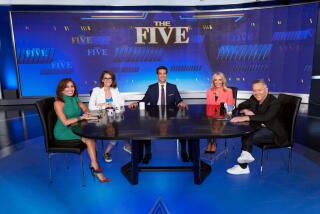C-SPAN marks 25 years of front-row democracy
Making laws, it has often been said, is a lot like making sausages -- you might be quite pleased with the final product but you really donât want to watch the process or know what goes into it.
The folks at C-SPAN disagree. They may not know bratwurst from knockwurst but they do know about laws -- the best and the wurst. Lawmaking and the whole, often-ugly legislative process is C-SPANâs entire raison dâetre, and on Friday, C-SPAN will celebrate its 25th anniversary of doing what no other news organization in this country does.
C-SPAN enables the American public -- that 10% of the American public thatâs really interested -- to watch the political process live, daily, gavel to gavel, whether itâs a routine session of the House of Representatives; an emotion-charged and Constitution-challenging committee hearing on Iran-Contra, gays in the military, Enron or homeland security; or a confirmation battle over Clarence Thomas, Robert Bork or Janet Reno.
Public cynicism toward the political process and those in government has increased steadily for more than 30 years, and voter turnout has declined just as steadily. I donât think thatâs a coincidence. But contrary to the conventional wisdom, voters may not have been turned off -- and away -- because theyâve seen too much of the process.
Rather, if the C-SPAN audience and research are any indication, the problem is that most Americans have seen too little; theyâve seen only the worst parts of the process -- the corruption, the scandals, the hypocrisy, the blatant displays of vested self-interest.
Brian Lamb -- the founder and CEO of C-SPAN -- says âearly indicationsâ from recent surveys done for his organization show that âthe people who watch us and see all those hearings and all that process, up close and personal, actually think better of the system than the ones who donât, because even though itâs not a pretty process, the watchers see it and understand it better.â
As a result, Lamb says, 90% of regular C-SPAN watchers are also regular voters -- a number thatâs about double the turnout for the public at large.
Yes, the legislative process can be boring, but over time, the insights it provides are invaluable -- especially now. At a time when most of the nationâs news media seem increasingly preoccupied with sensationalism and celebrity -- Melâs âPassion,â Marthaâs trial, Janetâs breast -- C-SPANâs role is increasingly important.
âFrom 1980 to 2000, public-affairs stories [in the nationâs newspapers] decreased from 70% of news coverage to 50%,â according to a Shorenstein Center study cited in Thomas Pattersonâs 2002 book, âThe Vanishing Voter.â During the same period, Patterson says, âCelebrity profiles, lifestyle scenes, hard-luck tales, good-luck tales and other human-interest stories rose from 11% to more than 20% of news coverage.â
An election-year essential
C-SPAN is the antidote to that toxic journalistic residue -- and never more so than in an election year, when C-SPANâs role expands exponentially.
C-SPAN has carried more than 2,000 hours of Campaign â04. On election night -- whether in Iowa or New Hampshire, Michigan or California -- C-SPAN doesnât dip in and out of various victory and concession speeches. It carries everything.
More important, using wireless microphones and other modern, small-is-better communications technology, C-SPAN is able to cover candidates not only when they make speeches but from the moment they step off the campaign bus until the moment they return.
âWe can blend in with the crowd, get close to the candidate and give our viewers the feeling that theyâre really at these events,â says Steve Scully, C-SPANâs political editor and senior executive producer. Thatâs what C-SPAN did at individual caucuses in Iowa, for example, and -- even before the caucuses -- when their cameras captured Howard Dean and his wife backstage in Dubuque, getting ready to meet a group of voters. And in New Hampshire, when a French couple approached John Kerry and asked him a question in French and he responded in French.
Candidates are coached and careful as never before, ever-mindful of the one slip that can doom their chances -- bye-bye, Dr. Dean -- but C-SPAN tries to overcome that unnatural (if understandable) inclination toward polish and pretense with its video verite approach.
âYou canât hide who you are as a candidate if weâre with you constantly,â Scully says. âSooner or later, your real personality will come through, warts and all.â
That certainly happened when C-SPAN showed Wesley Clark making a sharp, locker room-like retort to a New Hampshire voter who asked what would happen if supporters of President Bush criticized his military record.
The cable channel is not -- has never been -- for everyone. In a perhaps unguarded moment, Lamb once likened its appeal to that of opera or a symphony orchestra. But that appeal has grown enormously in the 25 years since C-SPAN -- with an original staff of four and an initial annual expenditure of $500,000 -- broadcast its first session of the U.S. House of Representatives to 3.5 million homes.
C-SPAN, which has since covered more than 25,000 hours of House floor action, now has 270 employees and an annual budget of $39 million. It broadcasts 24 hours a day, reaches 88 million homes -- 80% of the U.S. total -- and has spawned C-SPAN2, with 73 million subscribers, and C-SPAN3 (an all-digital network) with 8 million. (C-SPAN has 9 million subscribers in California, 50% more than in any other state.)
Bottom-line efficiency
C-SPAN claims about 25 million to 30 million regular viewers -- about the same number that watches such top-rated network shows as âCSIâ and âAmerican Idol.â But there are no Nielsen ratings for C-SPAN, so itâs difficult to determine just how many viewers watch it at any given time.
Thatâs not as important as it might seem, though, since C-SPAN -- which broadcasts no commercials -- survives entirely on payments from the cable and satellite companies that carry the service.
In essence, the companies pay C-SPAN an average of 5 cents a month for each subscriber -- and then presumably pass that charge on to the subscribers -- a figure that hasnât changed for eight years.
Why not?
âWe donât need more,â Lamb says with a frankness not characteristic of any business executive Iâve ever spoken with. âWe run efficiently, and because we have no Nielsen ratings and no advertising, we donât have to scramble for audience. We have the same mission now that we had when we started.â
That mission has broadened considerably, though. C-SPAN is now, for example, the prime broadcast venue for book news. Lamb himself conducts a weekly, hourlong interview with authors, and C-SPAN2 offers 48 hours of book coverage every weekend, featuring publishing news, author appearances and interviews and book festival programs (including The Timesâ annual Festival of Books).
But government and politics remain C-SPANâs âbasic mission,â as Lamb puts it.
I just wish C-SPAN could get President Bush to wear a wireless mike and allow video verite in the fall campaign. Iâd love to be able to eavesdrop on the president and, oh, say Karl Rove, discussing the administrationâs latest explanation for our troopsâ failure to find any weapons of mass destruction in Iraq.
David Shaw can be reached at [email protected]. To read his previous âMedia Mattersâ columns, please go to latimes.com/shaw-media.
More to Read
Get the L.A. Times Politics newsletter
Deeply reported insights into legislation, politics and policy from Sacramento, Washington and beyond. In your inbox three times per week.
You may occasionally receive promotional content from the Los Angeles Times.










